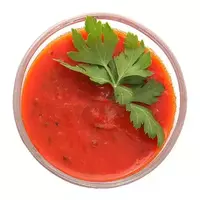Haris

Harissa or arissa is a famous hot sauce that is famous for the unprecedented palette of its taste and aroma. Harissa is prepared as a sauce or paste. Harissa pasta was the first to be made in Tunisia several centuries ago. Over time, harissa became a national dish not only of Tunisian, but also of Maghreb cuisine. El Maghreb, translated from Arabic "where the sun sets, " is the poetic name for a collection of small principalities that were located west of Egyptian lands.
Currently, the name of the city of Morocco in Arabic sounds like Maghreb. The classic composition of harissa sauce includes the following obligatory ingredients: red chilli, coriander, garlic, zira, olive oil and table salt. To soften the severity of the taste of harissa, the sauce is often supplemented with tomato paste, lemon vinegar or juice, as well as green olives. Chili peppers for harissa are used in dried or cured form. Fresh chili peppers will not give the paste the desired shade of burning and spicy taste.
In addition to the Arab world, harissa was appreciated by European culinary experts, who began to actively use the sauce. The interesting thing is that each country prepares harissa according to its own distinctive recipe. However, true connoisseurs and foodies recognize the primacy of Tunisian harissa sauce. If you think about it, this is not surprising, because only in the historical homeland of dishes, harissa sauce is prepared in compliance with the exact recipe.
Tunisian Harissa is distinguished by its incredibly sharp taste, which is perfectly combined with meat, fish and vegetable dishes. Harissa is used as a salad dressing, and pasta is also added to spicy soups. Harissa is thought to pair perfectly with pasta and rice. Petal harissa paste is considered an exotic treat made in Tunisia according to ancient recipes. Such harissa is served for a snack of tuna and green olives.
The fish flavour is perfectly complemented by harissa sauce and shaded with olives. Harissa can be made at home. However, it is worth carefully choosing the ingredients for the dish, because the taste, aroma and consumer qualities of the final product depend on their quality. For harissa paste, chilli is ground in a blender, where spices and olive oil garlic are added. It is worth remembering that harissa is a very hot sauce, so it is worth avoiding frequent consumption of the product for people with diseases of the gastrointestinal tract.
Chili pepper contained in harissa can cause complications with ulcers, gastritis, colitis and other diseases. On the other hand, harissa strengthens the body's immunity and has antibacterial and antimicrobial properties. Therefore, you should follow the measure, then harissa sauce will become a tasty and useful addition to your culinary masterpieces.
harissa 50 kKal
Energy value of harissa (Ratio of proteins, fats, carbohydrates - bju):
Proteins: 2 g (~ 8 kCal)
Fats: 1.5 g (~ 14 kCal)
Carbohydrates: 8g (~ 32kCal)
Energy ratio (b | y): 16% | 27% | 64%
 Español
Español Français
Français Português
Português Русский
Русский 简体中文
简体中文 繁體中文
繁體中文 日本語
日本語 한국어
한국어 العربية
العربية Türkçe
Türkçe Қазақ
Қазақ Deutsch
Deutsch Italiano
Italiano Українська
Українська
